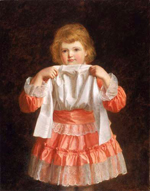
The Limits of Reason
"'What had his intelligence been given him for but to save him?" (79).
Henry James's The Turn of the Screw (1898)
Points for Reflection
H. James's The Turn of the Screw (1898), chps 14-24
- does the narrator's success at so accurately predicting where Flora disappeared to during Miles's piano performance fully, unequivocally validate her instincts concerning the invisible influence on the children? Do any other incidents support or explode the reader's faith in the narrator's point of view?
- how does Flora react when confronted with the idea of dead Miss Jessel's invisible, immediate presence?
- the narrator keeps coming back to the strange behavior of the children (49-52, 53-54), what she sometimes labels their odd "manner" (73). What exactly does she find so strange about the children's demeanor and actions?
- what meaning does the narrator discover/create in the two hours during which Miles sits silently next to his governess (72-73, 75)?
- what types of things might Miles have said at school that so discomfited the administration?
- at the beginning of this tale, the frame narrator notes that someone else has attempted a story which is “not particularly effective” (1). Is the central tale of The Turn of the Screw effective--is it successfully disturbing?
- after hearing the conditions under which the governess took her position from Douglas--before the story proper began--the frame story’s narrator proposed that the tale’s first moral lesson was that a young, inexperienced young women is easily manipulated by a dashing, older man who claims that he needs her to do something for him (6). Does Henry James himself encourage his reader to take away this particular message from the story, or to apply any other moral maps over his narrative? Are we supposed to derive any other lesson from this story?
- having finished the novella, which option do you find most plausible, most supported by the evidence?
- the narrator is delusional--she sees an invisible influence on the children, and the ghosts themselves--either because she needs to play the hero in the narrative of her own life, or because her religious background has trained her to see spiritual forces at work in everything
- the narrator's imagination and spiritual sensitivity tune her into real, if intangible, forces unrecognized by others
- the narrator is working out, through the children, some kind of personal, sexual trauma or repressed desire
- the narrator accurately assesses some of what she witnesses, but grossly misinterprets other elements of her experience at Bly

The New Frock (1889)
William Powell Frith
Dr. Paul Marchbanks
pmarchba@calpoly.edu
![]()
